Abstract
In late April 1984, an outbreak of Pontiac fever was investigated in an office building in lower Manhattan (New York City). The outbreak was characterized by a high attack rate (78 per cent overall); the predominant symptoms were myalgias, chills, fatigue, fever, and headache. There was a clustering of cases in an office that was air cooled by a dedicated cooling tower separate from the remainder of the building. A high concentration of live L. Pneumophila cells in the cooling tower was quantified. Airborne spread via settle plates placed along the air intake system and within the office was demonstrated. Legionella pneumophila serogroup 1 antigen was found in the urine of two cases, and identical monoclonal antibody reactivity patterns of isolates from all sources was observed. Difficulty was experienced in eliminating the organism from the tower.
Full text
PDF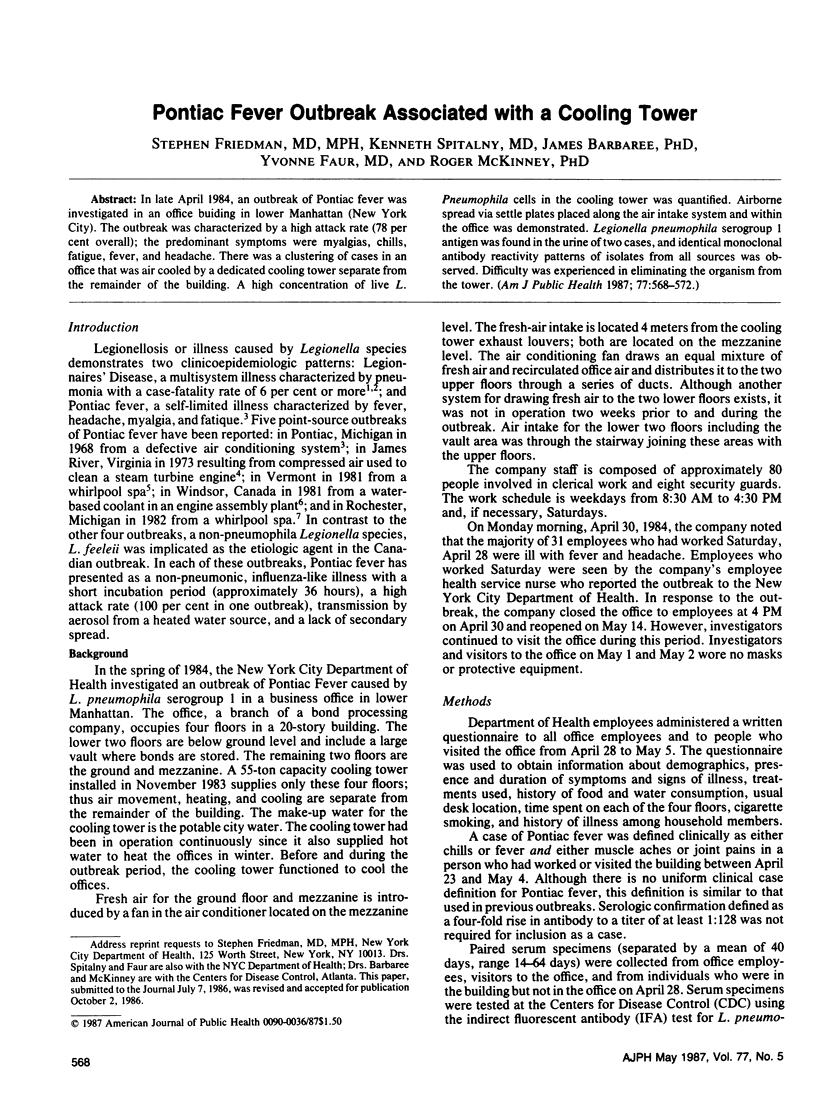
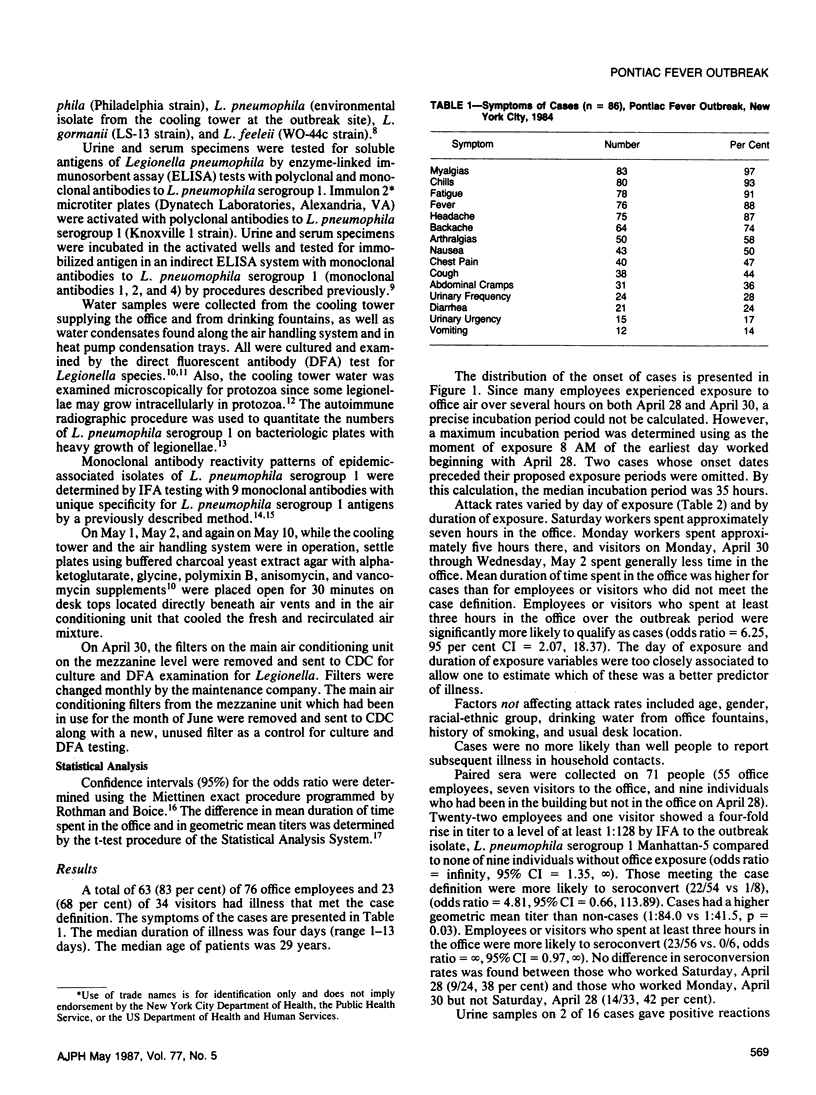
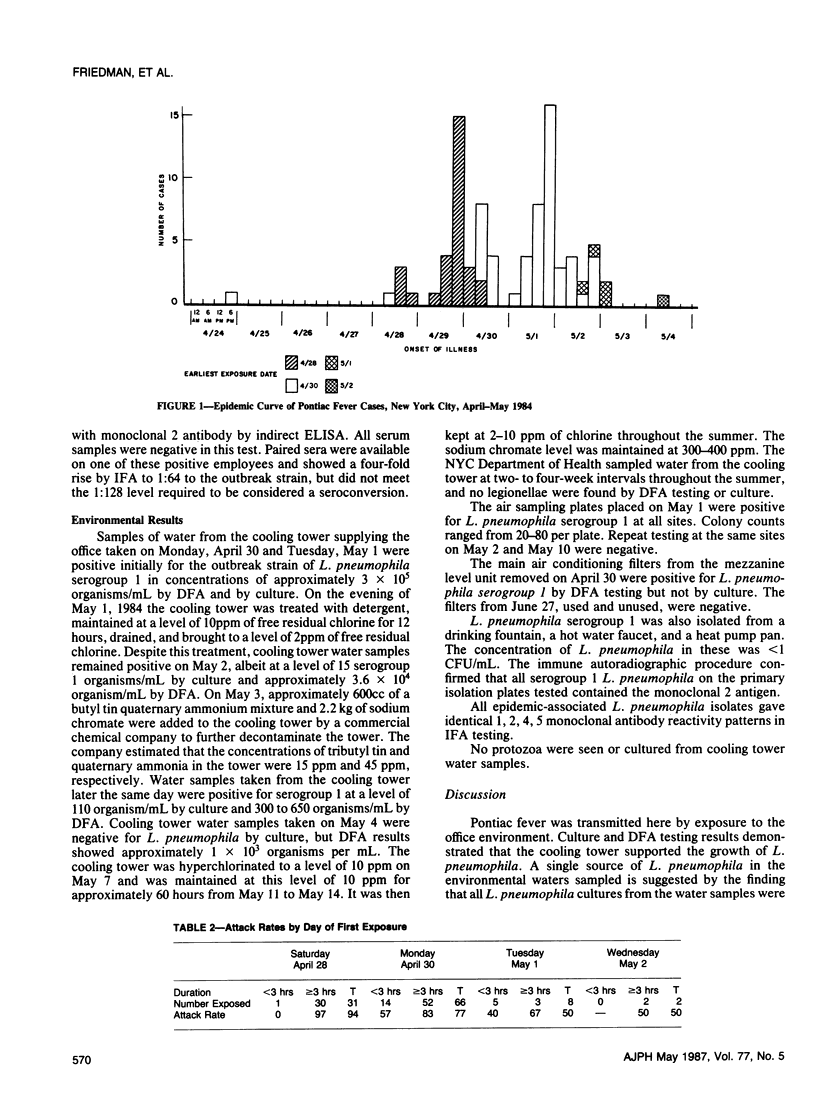
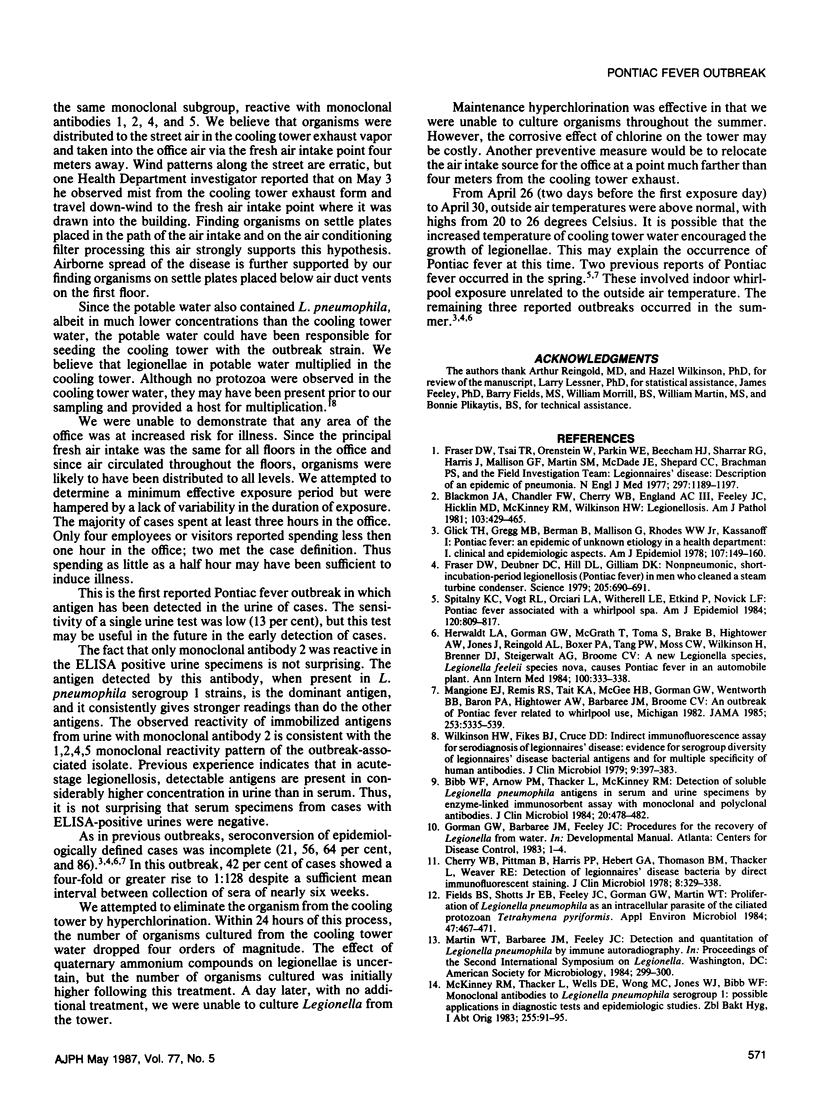
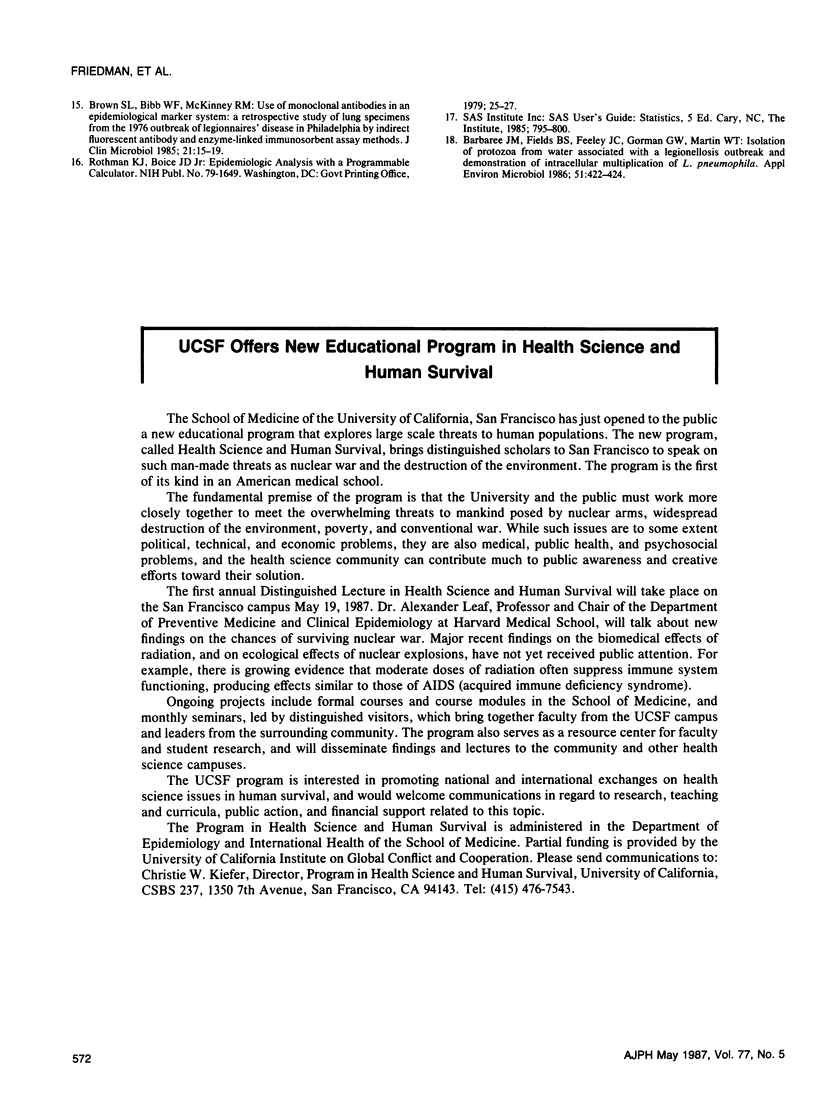
Selected References
These references are in PubMed. This may not be the complete list of references from this article.
- Barbaree J. M., Fields B. S., Feeley J. C., Gorman G. W., Martin W. T. Isolation of protozoa from water associated with a legionellosis outbreak and demonstration of intracellular multiplication of Legionella pneumophila. Appl Environ Microbiol. 1986 Feb;51(2):422–424. doi: 10.1128/aem.51.2.422-424.1986. [DOI] [PMC free article] [PubMed] [Google Scholar]
- Bibb W. F., Arnow P. M., Thacker L., McKinney R. M. Detection of soluble Legionella pneumophila antigens in serum and urine specimens by enzyme-linked immunosorbent assay with monoclonal and polyclonal antibodies. J Clin Microbiol. 1984 Sep;20(3):478–482. doi: 10.1128/jcm.20.3.478-482.1984. [DOI] [PMC free article] [PubMed] [Google Scholar]
- Blackmon J. A., Chandler F. W., Cherry W. B., England A. C., 3rd, Feeley J. C., Hicklin M. D., McKinney R. M., Wilkinson H. W. Legionellosis. Am J Pathol. 1981 Jun;103(3):429–465. [PMC free article] [PubMed] [Google Scholar]
- Brown S. L., Bibb W. F., McKinney R. M. Use of monoclonal antibodies in an epidemiological marker system: a retrospective study of lung specimens from the 1976 outbreak of Legionnaires disease in Philadelphia by indirect fluorescent-antibody and enzyme-linked immunosorbent assay methods. J Clin Microbiol. 1985 Jan;21(1):15–19. doi: 10.1128/jcm.21.1.15-19.1985. [DOI] [PMC free article] [PubMed] [Google Scholar]
- Cherry W. B., Pittman B., Harris P. P., Hebert G. A., Thomason B. M., Thacker L., Weaver R. E. Detection of Legionnaires disease bacteria by direct immunofluorescent staining. J Clin Microbiol. 1978 Sep;8(3):329–338. doi: 10.1128/jcm.8.3.329-338.1978. [DOI] [PMC free article] [PubMed] [Google Scholar]
- Fields B. S., Shotts E. B., Jr, Feeley J. C., Gorman G. W., Martin W. T. Proliferation of Legionella pneumophila as an intracellular parasite of the ciliated protozoan Tetrahymena pyriformis. Appl Environ Microbiol. 1984 Mar;47(3):467–471. doi: 10.1128/aem.47.3.467-471.1984. [DOI] [PMC free article] [PubMed] [Google Scholar]
- Fraser D. W., Deubner D. C., Hill D. L., Gilliam D. K. Nonpneumonic, short-incubation-period Legionellosis (Pontiac fever) in men who cleaned a steam turbine condenser. Science. 1979 Aug 17;205(4407):690–691. doi: 10.1126/science.462175. [DOI] [PubMed] [Google Scholar]
- Fraser D. W., Tsai T. R., Orenstein W., Parkin W. E., Beecham H. J., Sharrar R. G., Harris J., Mallison G. F., Martin S. M., McDade J. E. Legionnaires' disease: description of an epidemic of pneumonia. N Engl J Med. 1977 Dec 1;297(22):1189–1197. doi: 10.1056/NEJM197712012972201. [DOI] [PubMed] [Google Scholar]
- Glick T. H., Gregg M. B., Berman B., Mallison G., Rhodes W. W., Jr, Kassanoff I. Pontiac fever. An epidemic of unknown etiology in a health department: I. Clinical and epidemiologic aspects. Am J Epidemiol. 1978 Feb;107(2):149–160. doi: 10.1093/oxfordjournals.aje.a112517. [DOI] [PubMed] [Google Scholar]
- Herwaldt L. A., Gorman G. W., McGrath T., Toma S., Brake B., Hightower A. W., Jones J., Reingold A. L., Boxer P. A., Tang P. W. A new Legionella species, Legionella feeleii species nova, causes Pontiac fever in an automobile plant. Ann Intern Med. 1984 Mar;100(3):333–338. doi: 10.7326/0003-4819-100-3-333. [DOI] [PubMed] [Google Scholar]
- Mangione E. J., Remis R. S., Tait K. A., McGee H. B., Gorman G. W., Wentworth B. B., Baron P. A., Hightower A. W., Barbaree J. M., Broome C. V. An outbreak of Pontiac fever related to whirlpool use, Michigan 1982. JAMA. 1985 Jan 25;253(4):535–539. [PubMed] [Google Scholar]
- McKinney R. M., Thacker L., Wells D. E., Wong M. C., Jones W. J., Bibb W. F. Monoclonal antibodies to Legionella pneumophila serogroup 1: possible applications in diagnostic tests and epidemiologic studies. Zentralbl Bakteriol Mikrobiol Hyg A. 1983 Jul;255(1):91–95. [PubMed] [Google Scholar]
- Spitalny K. C., Vogt R. L., Orciari L. A., Witherell L. E., Etkind P., Novick L. F. Pontiac fever associated with a whirlpool spa. Am J Epidemiol. 1984 Dec;120(6):809–817. doi: 10.1093/oxfordjournals.aje.a113953. [DOI] [PubMed] [Google Scholar]
- Wilkinson H. W., Fikes B. J., Cruce D. D. Indirect immunofluorescence test for serodiagnosis of Legionnaires disease: evidence for serogroup diversity of Legionnaires disease bacterial antigens and for multiple specificity of human antibodies. J Clin Microbiol. 1979 Mar;9(3):379–383. doi: 10.1128/jcm.9.3.379-383.1979. [DOI] [PMC free article] [PubMed] [Google Scholar]


